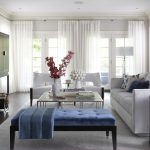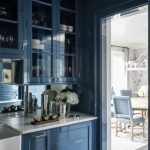

An interview with Renée Byers
How do you look at an outside differently to know how to begin your project?
We start our design process by listening to our clients and family to hear what they want for the property, what they like and dislike most about what they have, and what qualities they’ve loved the most from gardens they’ve seen elsewhere. This first step is very similar for interior and architectural concept design as well. The main differences that landscape architects must consider in creating successful landscape designs is that our work must be done in concert with nature, the ever-changing macro and micro-climates of the outdoors, while maintaining sensitivity to both the architectural and neighborhood context. We always look at how a new environment ought to function for the client. The physical bones of a new landscape take shape after considering many factors: the size of seating/gathering areas, the driveway and physical approach to the property, terraces, swimming pools, cabanas, tennis courts, pergolas, walls and walks, all the components begin to take form after massaging them into their architectural and topographic surroundings. At the same time, we are factoring in sun, shade, wind, views, slope, as well as the natural structure created by existing trees and new plantings. Through programming, site analysis and the synthesis of the two, we begin to conceptualize forms that will define and create a cohesive environment for a series of memorable garden “rooms” that are created uniquely for the individual owner and particular site.
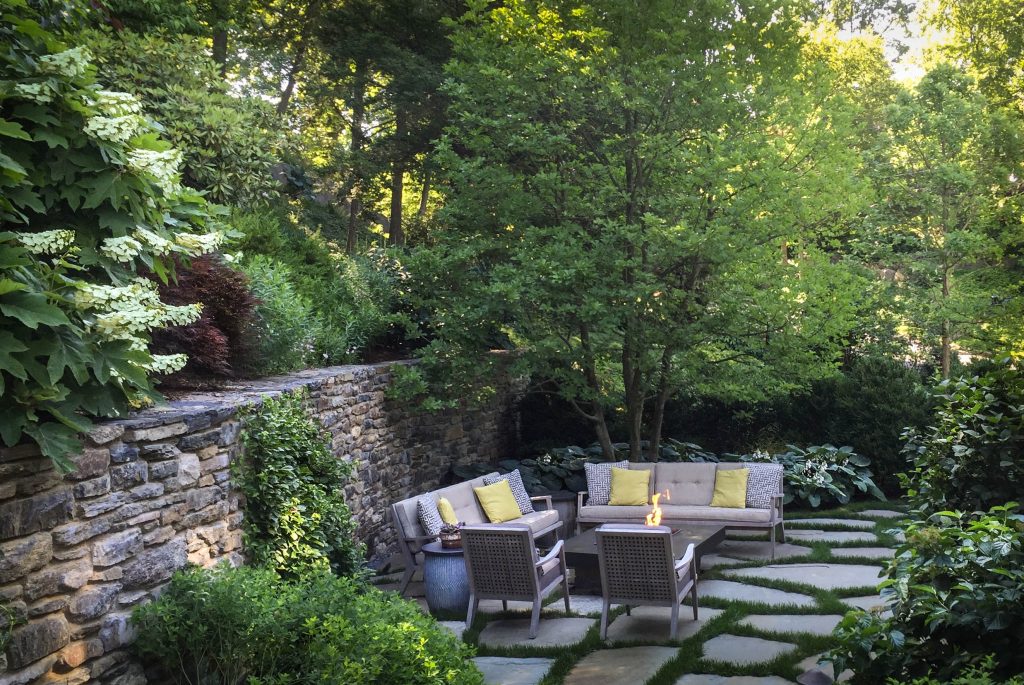 A formerly unused side yard now welcomes guests to gather ’round a custom firepit. The space was enlarged by the construction of a retaining wall to form an informal walled garden with lush plantings, after the client requested an inviting seating/ entertaining area.
A formerly unused side yard now welcomes guests to gather ’round a custom firepit. The space was enlarged by the construction of a retaining wall to form an informal walled garden with lush plantings, after the client requested an inviting seating/ entertaining area.
What do you consider when choosing your plants?
We use the old adage of the “right plant in the right place.” There are literally thousands of plants to choose from. But after factoring in existing conditions like, sun, shade, hardiness zone, the purpose of the planting-say privacy or structure, or focal point, rain garden, shade-giver, or garden room divider, to name just a few, the field of choices begins to narrow quite quickly. Experience teaches us which plants require the least spraying and maintenance, the best performers for a given situation, ideal mature size–basically, and which plants will create the narrative of elegant simplicity that we are usually seeking.
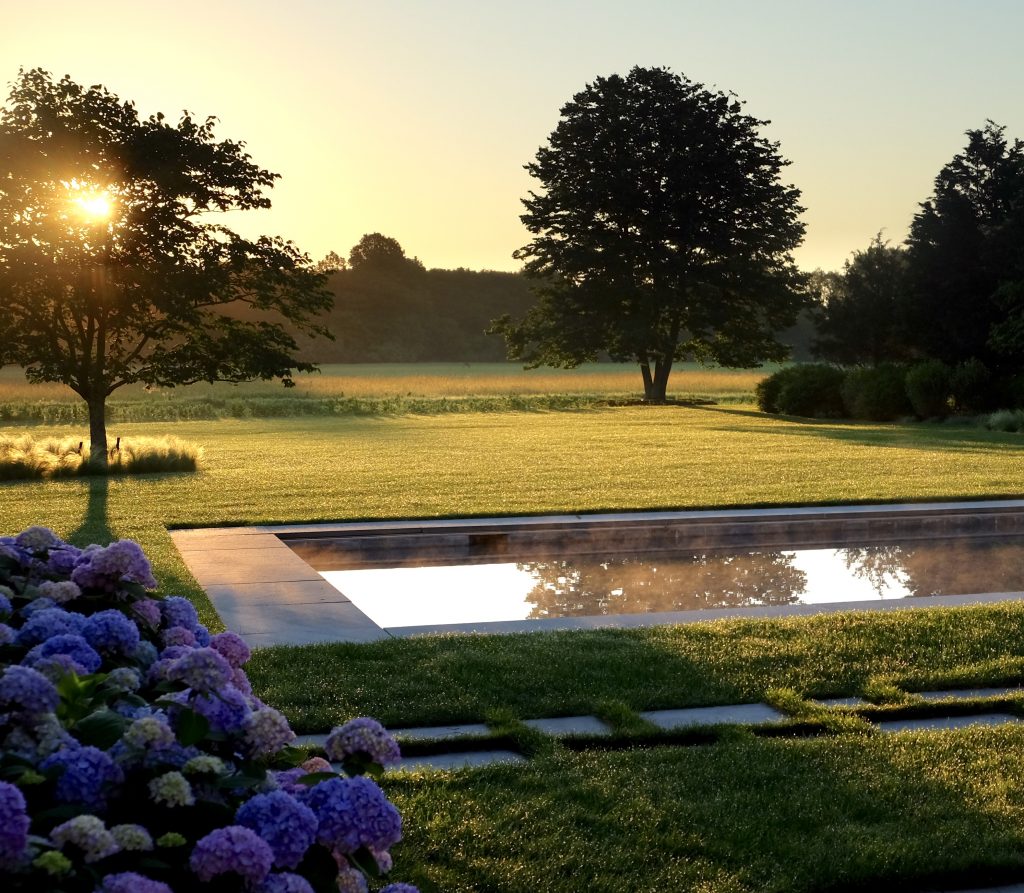 Here Renée positioned the specimen triple-trunk Linden on the right to frame the view of the meadow beyond. This is an example where a single specimen is so much more effective at drawing the eye than a group of small trees
Here Renée positioned the specimen triple-trunk Linden on the right to frame the view of the meadow beyond. This is an example where a single specimen is so much more effective at drawing the eye than a group of small trees
What has been the most difficult but exciting installation and why?
Well, that’s a tough one because I love what we do so much, I am always excited when projects come to fruition! We had a project a while back on a small site, which was extremely steep—a beautiful historic home on less than half an acre, with a sixty foot drop from the front door to the back of the back yard. But the clients placed their trust in us and we worked with the very best masons and plantsmen to create an exciting, beautiful, and surprisingly functional multi-level garden. The crew was absolutely tireless as they moved earth, stone, concrete and specimen plants, all by hand labor only, since the property was too steep for access with any machine equipment. Though we won a design award for this garden, the best thing about the project was the long-term friendship we formed with the family who commissioned us, and seeing how the garden evolved and worked for them over many years.
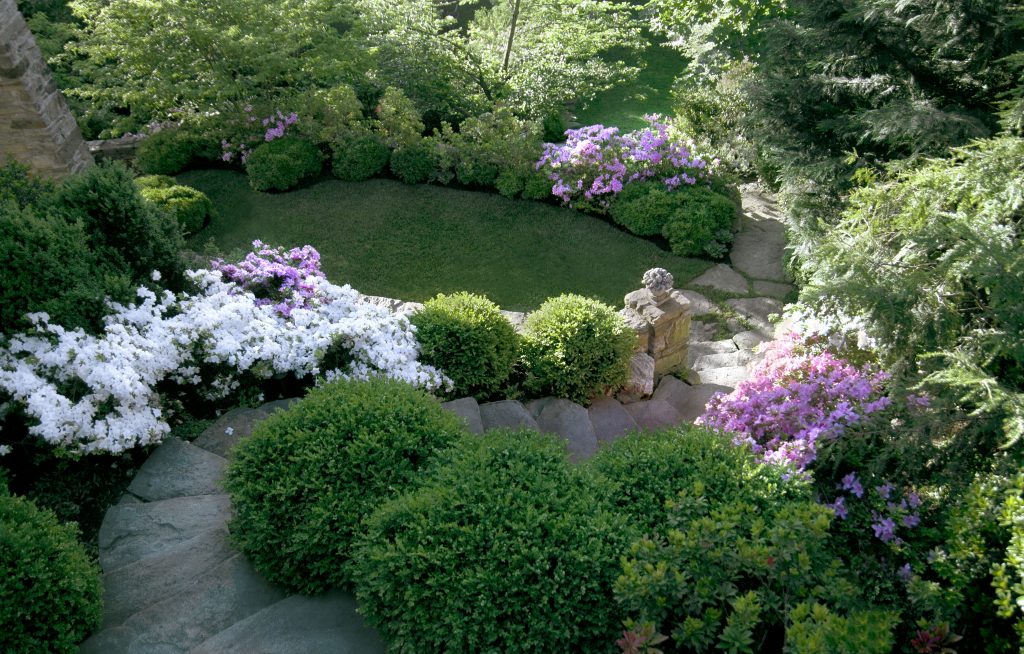 Example of a challenging but rewarding hillside garden where every stone, tree and shrub was brought in and placed by hand, since the site was too steep for any equipment. A series of garden rooms were terraced into the steep slopes.
Example of a challenging but rewarding hillside garden where every stone, tree and shrub was brought in and placed by hand, since the site was too steep for any equipment. A series of garden rooms were terraced into the steep slopes.
What is a popular request in this area that we may not see as often in other areas?
As far as plantings go, I would say deer-resistant plants, and for waterfront and wetland areas, plants tolerant of salt and additional water are popular requests somewhat specific to our geographic locale; likewise built-in snowmelt systems, not only for driveways, but some key outdoor spaces and walkways as well. Since many in this locale have neighbors close by, people are often looking to create very private gardens, with amenities like well-furnished terraces, firepits, swimming pools, and outdoor kitchens.
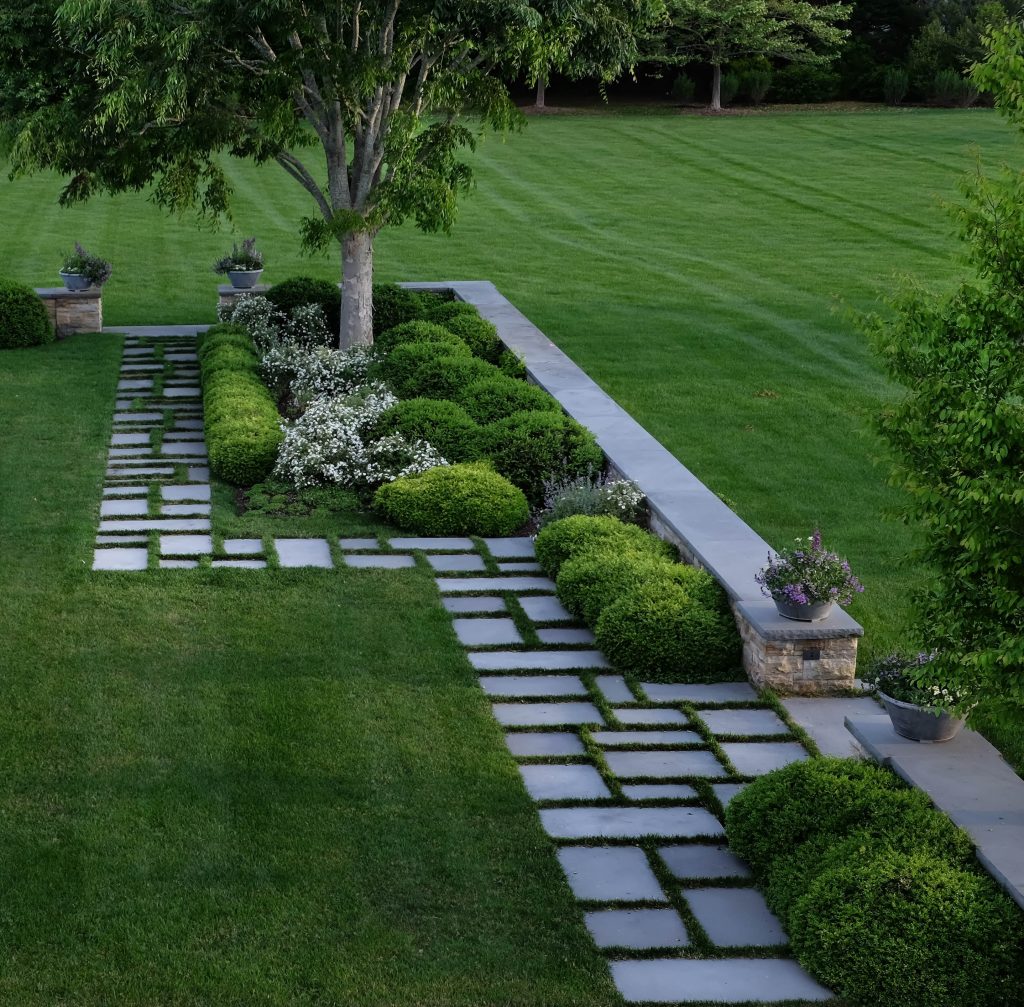 Example of deer resistant, but elegant plantings of white flowering potentilla, spreading boxwood and catmint. Low stone walls are used to create a sense of enclosure for the garden; a specimen zelkova anchors the corner.
Example of deer resistant, but elegant plantings of white flowering potentilla, spreading boxwood and catmint. Low stone walls are used to create a sense of enclosure for the garden; a specimen zelkova anchors the corner.
How do you determine the best plants/trees to install?
I would build upon my answer to your earlier question of what we consider in choosing our plants. Once we look at all the favorites and requests of the clients for suitability for their own garden, and after we determine the function each plant or group of plants is to serve, we prepare a general planting plan. The most critical next step involves trips to plant nurseries and tree farms by my team and me, to personally tag each and every tree and shrub for each project. We sometimes originally think we want one specific tree species, but once at the nursery, we might find a perfect, but different specimen that fits the bill even better. By developing relationships with many wholesale nurseries and growers over the decades, we are able to find the best plants and trees that are currently available for our clients and to create gardens that can be enjoyed for the long term.
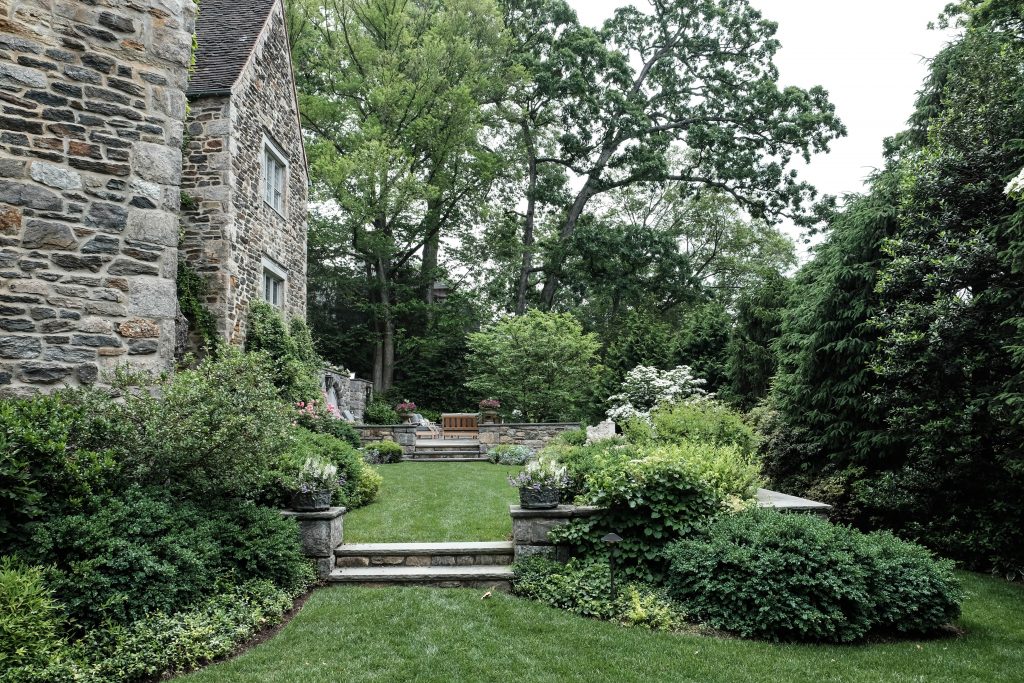 The structure of this garden was first established by the stone walls that Renée designed, then layered plantings to reinforce and soften the lines. Each plant serves a function, from year-round screen, to flowering shrub, to architectural anchor.
The structure of this garden was first established by the stone walls that Renée designed, then layered plantings to reinforce and soften the lines. Each plant serves a function, from year-round screen, to flowering shrub, to architectural anchor.
How do you go about designing gates and patios/ walls for clients? What do you consider when coming up with the aesthetic?
After carefully unpacking what the clients have said they want to achieve in their outdoor living areas in terms of function and privacy, we look at the architecture of the main house to inform our approach to style. No matter the architectural period, the most successful garden aesthetic comes from a thorough understanding of the rules of proportion and scale. Whether a traditional or modern home, we aim to design spaces that appear as though they have belonged there from the beginning; we try to use the best quality materials that can withstand our harsh climate and actually look better over time. We do everything possible to keep the lines of the garden simple and elegant, as we have found that nature provides all the variety and color we need; the bones of the garden should usually remain strong, but quiet. Our highest compliment is when people say they can’t tell what was already there from what we did. The spaces should just feel wonderful to be in without distracting the eye from nature.
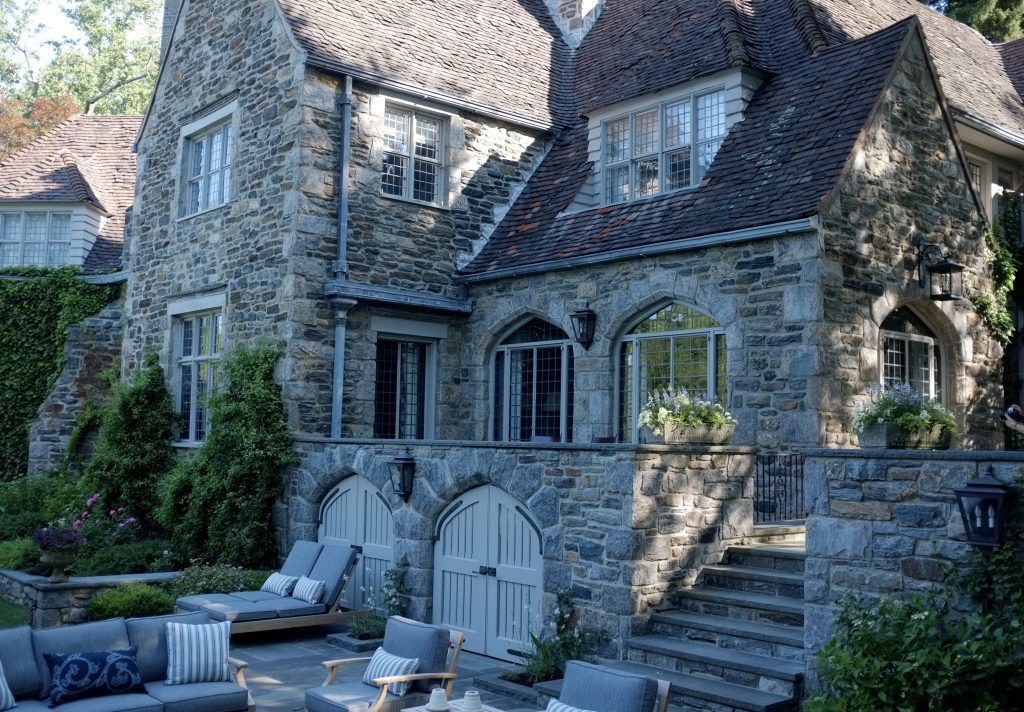 For this historic home, Renée designed a pair of arched wood gates to conceal a storage area under the breakfast terrace. Their style reflects the architecture of the house, without distracting from it.
For this historic home, Renée designed a pair of arched wood gates to conceal a storage area under the breakfast terrace. Their style reflects the architecture of the house, without distracting from it.
…………………………………………..
For more information on Renée Byers Landscape Architect, P.C. go to Renee Byers



